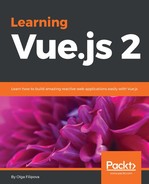In the previous chapter, we made our applications go live by deploying them to a server and making them available to the world. We have also guaranteed continuous integration and continuous deployment of our applications. This means that every time we commit changes performed on the applications, they will automatically be tested and deployed.
It seems that our journey in this book has finished. But, in fact, it has just started. After all we have discovered and learned, there is still so much to do! In this chapter, we will wrap up everything we have learned so far and see what we still have to learn and what nice things we still can do to reach the level of awesomeness of our applications. So, in this chapter, we will do the following:
- Wrap up everything we have learned so far
- Make a list of follow up things
We have been on a big journey so far, and it's time to sum up what we have done and what we have learned.
In Chapter 1, Going Shopping with Vue.js, we had our first date with Vue.js. We talked about what Vue.js is, how it was created, and what it does and saw some basic examples.
In Chapter 2, Fundamentals - Installing and Using, we went deep into behind the scenes of Vue.js. We learned about MVVM architectural pattern, we saw how does Vue.js work, and we touched different aspects of Vue.js such as components, directives, plugins, and application state. We learned different ways of installing Vue.js, starting from using a simple standalone compiled script, passing by using the CDN version, NPM version, and going toward using the development version of Vue.js being able to not only use it but also contribute to its codebase . We learned how to debug and how to scaffold Vue.js application using Vue-cli. We have even created a really simple Chrome application using CSP-compliant version of Vue.
In Chapter 3, Components - Understanding and Using, we put our hands deep inside the component's system. We learned how to define Vue components, how component's scope works, and how do components relate to each other, and we started using single-file components in the applications that we have bootstrapped before.
In Chapter 4, Reactivity - Binding Data to Your Application, we went deep into data binding and reactivity with Vue.js. We learned how to use directives, expressions, and filters. We brought data binding to the applications developed in the initial chapters and made them interactive, thanks to the reactivity fashion of Vue.js.
In Chapter 5, Vuex - Managing State in Your Application, we learned how to manage global state in Vue applications using the Vuex store system. We learned how to use state, actions, getters, and mutations in order to create a modular and nice application structure where the components can easily communicate with each other. We applied this new knowledge in our applications that we developed so far in the previous chapters.
In Chapter 6, Plugins - Building Your House with Your Own Bricks, we learned how Vue plugins cooperate with Vue applications. We used an existing plugin, vue-resource, which helped us to save the application's state between browser refreshes. We also created our own plugin for Vue applications that produces white, brown, and pink noises. At this point, we had fully functional applications with a quite nice set of working features.
In Chapter 7, Testing - Time to Test What We Have Done So Far!, we learned how to test our Vue applications. We learned how to write unit tests and how to create and run end-to-end tests with Selenium driver. We learned what code coverage is and how to fake server responses in unit tests. We covered almost 100% of our code with unit tests and we saw the Selenium driver in action running our end-to-end tests.
In Chapter 8, Deploying - Time to Go Live!, we finally exposed our applications to the whole world. We deployed them to the Heroku cloud system and now they can be accessed from everywhere where the Internet exists. More than that, we made our deployment process completely automated. Each time we push code changes to the master branch, the application is deployed! Even more than that. They are not only deployed on each push, but also automatically tested with the Travis continuous integration system.
Thus, in this book, we haven't just learned a new framework. We applied our knowledge to develop two simple, yet nice applications from scratch. We applied the most important Vue's concepts to make our applications reactive, fast, maintainable, and testable. However, this is not the end. During the writing of this book, Vue 2.0 has been launched. It brings some new possibilities and some new things to learn and use.
